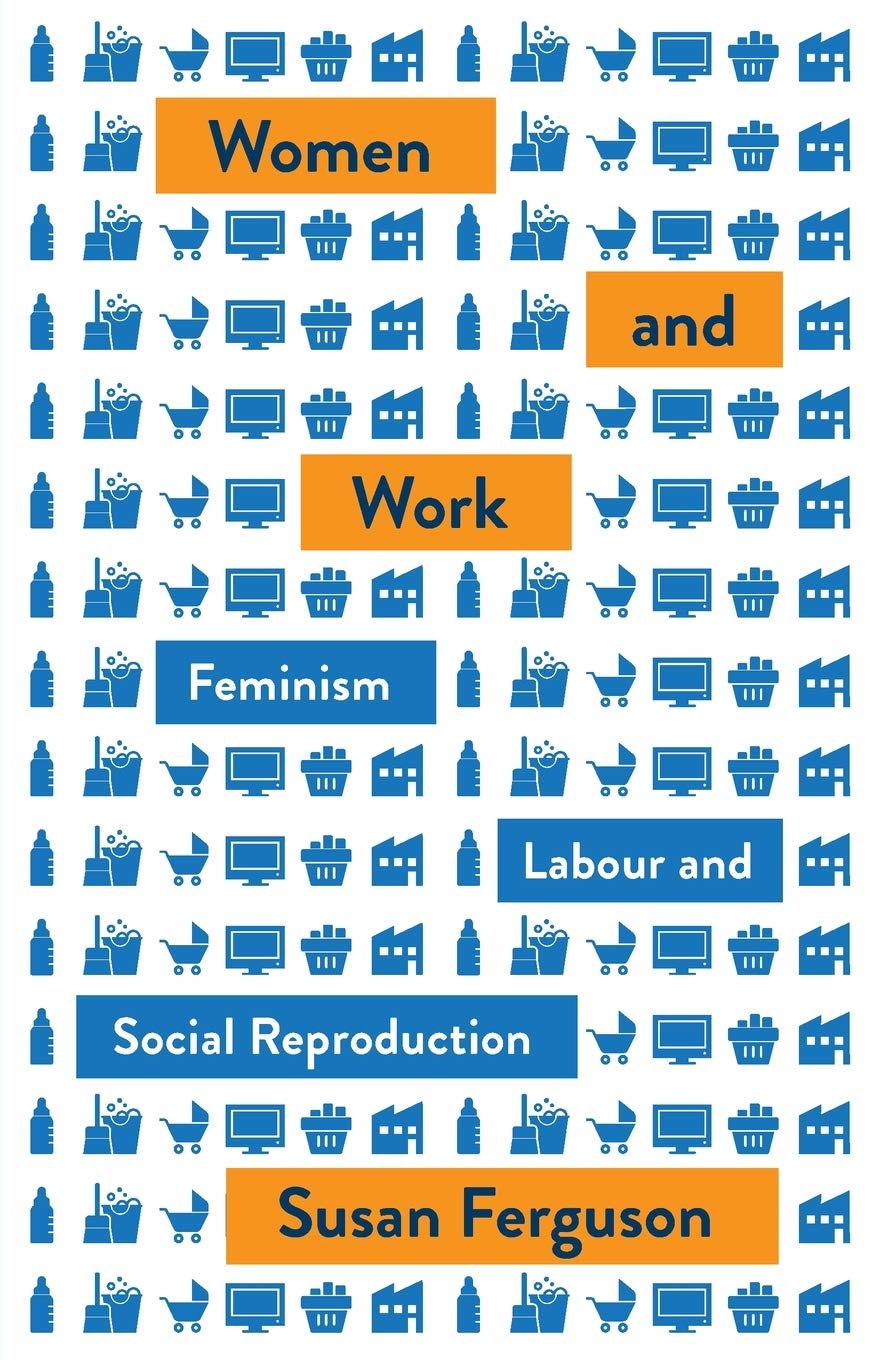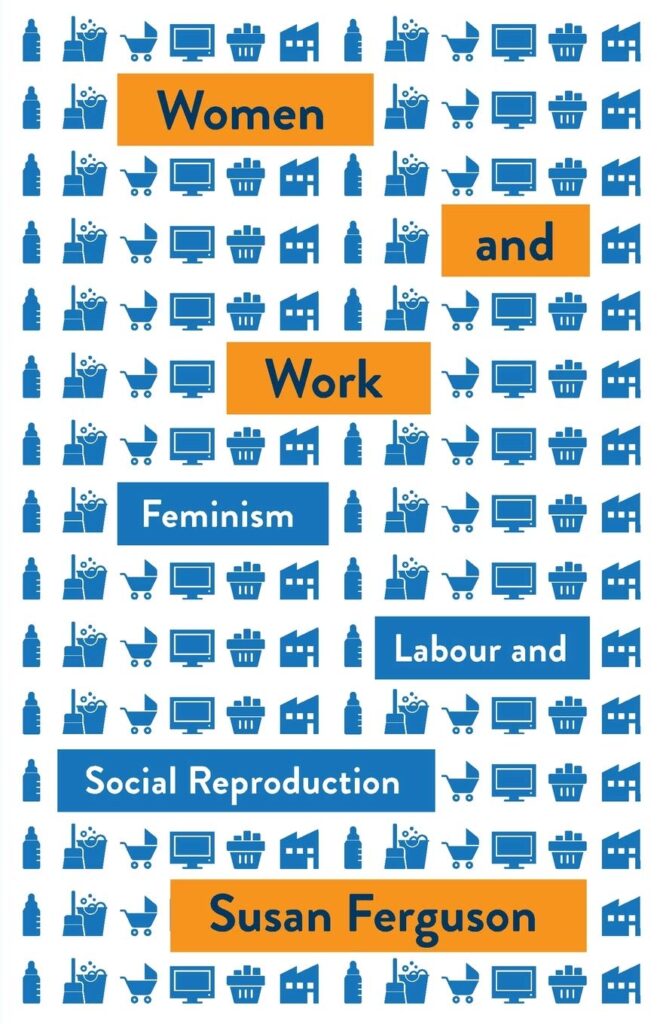
A Review of Women and Work by Susan Ferguson
Maud Perrier
SPAIS
Gender Research Centre, Faculty of Social Sciences and Law, University of Bristol, UK
Maud.Perrier@bristol.ac.uk
Abstract
This article discusses Susan Ferguson’s Women and Work and how it advances contemporary debates about social reproduction within and beyond Marxist feminism. In particular, I emphasise its call for avoiding hierarchising struggles against oppression and those against exploitation, and for centring a dual-terrains approach. The article calls upon social-reproduction scholars to learn from Ferguson’s careful approach to writing the pasts and presents of social reproduction, and also calls for a further widening of the archives from which the political theory of women’s labour struggles is written.
Keywords
social reproduction – labour – feminism – struggle
Susan Ferguson, (2019) Women and Work: Feminism, Labour and Social Reproduction, London: Pluto Press.
Women and Work: Feminism, Labour and Social Reproduction (Pluto Press, 2019) presents a masterful analysis of three centuries of feminist deliberations on work, carefully tracing how the fault lines of social-reproduction theory emerged. Given the troubling lack of precision in terms of how the concept of social reproduction is deployed in academic debate, inside and beyond orthodox Marxism, Ferguson’s book stands out as offering precisely the analytical rigour needed to take this scholarly resurgence forward. Women and Work shows why an historical and nuanced appreciation of the social-reproduction perspective is crucial to analysing contemporary anti-capitalist feminist struggles. In a time when postwork feminist critiques such as Kathi Weeks’s The Problem with Work
The question of women’s work and its relation to oppression most animated feminist theorising in the 1970s, and this book stands shoulder to shoulder with such Marxist-feminist classics as Lise Vogel’s Marxism and the Oppression of Women
Divided into two parts, the book analyses the history of feminist thought on labour through three different perspectives: equality feminism, social-reproduction feminism and critical-equality feminism. While equality feminism is associated with the rational-humanist tradition of Wollstonecraft, critical-equality feminism is described as sharing ‘social reproduction’s feminist critique of capitalism’s separation of productive and non-productive work, but […] without elaborating a political-economic analysis of unpaid women’s work’ (p. 4). The limitation of critical-equality feminism, according to Ferguson, lies in its tendency to conceive of patriarchy and capitalism as dual, distinct systems of oppression, and she illustrates the ways in which this has narrowed the scope of analysis for authors as wide ranging as Flora Tristan and Clara Zetkin. Chapter 3 discusses the significance of the less well-known socialist thinkers Anna Wheeler and William Thompson, and identifies their book The Appeal (1825) as a radical departure from contemporary works, they being among the first socialists to analyse unproductive housework as integral to the system of reproductive labour. Ferguson highlights how Wheeler and Thompson (and to some extent Inman’s) theorising of unpaid work was consistently erased from socialist thought and party politics, and how this continues in virtue of the way feminist theory is received via canonised ‘founders’ and simplified categories, hence calling out significant erasures in the telling of socialist-feminist histories.
The discussion of what constitutes a social-reproductive strike and her engagement with the ideas of Federici and Weeks are some of the most stimulating parts of the book for those interested in contemporary social-reproduction movements. The care with which Ferguson develops her analysis is exemplary: where, in the course of making her argument, she departs from Fortunati and Federici’s autonomist perspective, she stresses points of similarity in their approaches, namely that working within and outside capitalist relations are not mutually exclusive strategies. Ultimately, she argues that the distinction between productive and unproductive labour under capitalism disappears in their analysis of value production. Her claim that Fortunati’s alternative theory of value transfer is imprecise and too randomly based on Marx’s categories (p. 125) might have been even more convincing had it been developed in more detail. For Ferguson, the Marxian school’s perspective is superior because it highlights how capitalist subsumption is not a totalising process, a dimension she claims autonomists underestimate. Hence her argument for the necessity of centring struggles from within capitalist relations, rather than developing alternative value communities outside capital. Her critique of autonomists is rendered incisive by what she identifies as missing from their accounts. She points out that Federici, Weeks and others are silent about the significance of workplace-based struggles, and neglect to discuss how solidarity between the employed and the unemployed could be built, a point also echoed in Pitts and Dinerstein’s most recent book. In turn, this strengthens her argument that the Marxian perspective is the one best able to guide a mass movement that bridges struggles on productive and reproductive terrains. This argument is made more compelling by the examples she chooses, such as Eric Blanc’s study of the 2018 US teachers’ strikes
The differentiated analysis of capital as producing unequal and divided workforces broadens the relevance of the book out to those scholars analysing the social organisation of labour. The story of how oppressed groups came to identify capital’s interest in ensuring that marginalised groups of women are paid poverty wages to perform social-reproductive work is surely foundational, yet this insight often remains left out of mainstream intersectional analyses. The book also illustrates the ways in which observing and standing with workers catalysed the insights of the theorists she foregrounds. She writes evocatively about Flora Tristan’s observations on French washer women’s ill-health due to exposure to polluted water and dyes, and the nineteenth-century African American abolitionist feminist Maria Stewart’s speech about domestic labour as servitude: ‘How long shall the fair daughters of Africa be compelled to bury their minds and talents beneath a load of iron pots and kettles?’ (p. 73). She thus brings our attention to the significance of the historical and material conditions of knowledge-production for Marxist theory and shows us that, then as today, the act of seeing workers matters for analysing processes of revolutionary consciousness.
Women and Work has few shortcomings as critical theory, because it is both erudite and sharp. Ferguson’s highlighting of the critical-equality perspective as having an important role in the development of Marxist feminism is an important contribution, because too often the categories of liberal feminism and Marxist feminism are mis-characterised as respectively reformist and revolutionary, descriptions which are ‘too blunt to capture the assumptions shared by both traditions’ (p. 60). Yet, I wanted to know how these categories translate into contemporary feminist and left politics today, and what alliances between critical-equality and social-reproduction feminism she thinks are worth pursuing given the shifting political terrain since 2010. Those are clearly questions for other scholars of social movements to reflect on, but Ferguson’s take on them will have convinced the reader further of why these categories continue to matter. The book brings classic feminist-Marxist texts vividly to life, but left me with many questions about the present: how do the increased contradictions between paid and unpaid social reproduction that characterise many women’s lives today reinvigorate these foundational texts? For example, the financialisation of sectors such as care work and education poses particular questions for theorising women’s labour struggles. Ferguson clearly sees both unions and grassroots groups as having a unique role to play in these struggles, but their historically distinct articulations are not always acknowledged. I was also curious about what her argument means for building alliances that centre the distinctive experiences of migrant and informal workers’ organising, given this stratification plays a significant role in international labour struggles that have massively transformed studies and struggles of women’s labour over the last fifty years. Those are ever more pressing questions for theorising women’s labour in a way that centres global inequalities.
Ferguson characterises the best social-reproduction feminism accounts as being neither purely historical nor purely abstract.
The book’s approach to dislodging unpaid housework from the centre of social-reproduction theory and her case for the importance of building bridges with workplace-based struggles mean that this book will remain a landmark of Marxist-feminist thought for years to come. Ferguson develops social-reproduction theory as a multi-faceted critical theory of oppression, and shows the importance of tracing its roots critically and thoroughly. The significance of workplace organising is especially ripe at a time when nursery workers’, fast-food workers’, teachers’ and home-care workers’ unions are seeing a resurgence in their membership’s appetite for strikes. As Ferguson discusses in a recent interview,
References
Arruzza, Cinzia, Tithi Bhattacharya and Nancy Fraser 2019, Feminism for the 99%: A Manifesto, London: Verso.
Bhattacharya, Tithi (ed.) 2017, Social Reproduction Theory: Remapping Class, Recentering Oppression, London: Pluto Press.
Blanc, Eric 2019, Red State Revolt: The Teachers’ Strike Wave and Working-Class Politics, London: Verso.
Boris, Eileen 2019, Making the Woman Worker: Precarious Labor and the Fight for Global Standards, 1919–2019, New York: Oxford University Press.
Cobble, Dorothy Sue 2010, ‘More Intimate Unions’, in Intimate Labors: Cultures, Technologies, and the Politics of Care, edited by Eileen Boris and Rhacel Salazar Parreñas, pp. 280–95, Stanford, CA: Stanford University Press.
Dinerstein, Ana Cecilia and Frederick Harry Pitts 2021, A World Beyond Work?: Labour, Money and the Capitalist State between Crisis and Utopia, Bingley: Emerald Publishing Ltd.
Ferguson, Susan 2016, ‘Social Reproduction: What’s the Big Idea?’, available at: <https://www.plutobooks.com/blog/social-reproduction-theory-ferguson/>.
Giménez, Martha E. 2018, Marx, Women, and Capitalist Social Reproduction: Marxist-Feminist Essays, Historical Materialism Book Series, Leiden: Brill.
Hemmings, Clare 2005, ‘Telling Feminist Stories’, Feminist Theory, 6, 2: 115–39, <doi:10.1177/1464700105053690>.
Perrier, Maud M. (forthcoming), Contemporary Childcare Struggles: Maternal Workers and Social Reproduction, Bristol: Bristol University Press.
Rowbotham, Sheila 2013 [1972], Women, Resistance and Revolution: A History of Women and Revolution in the Modern World, London: Verso.
Vogel, Lise 2013 [1983], Marxism and the Oppression of Women: Toward a Unitary Theory, Revised Edition, Historical Materialism Book Series, Leiden: Brill.
Weeks, Kathi 2011, Feminism, Marxism, Antiwork Politics, and Postwork Imaginaries, Chapel Hill, NC: Duke University Press.

